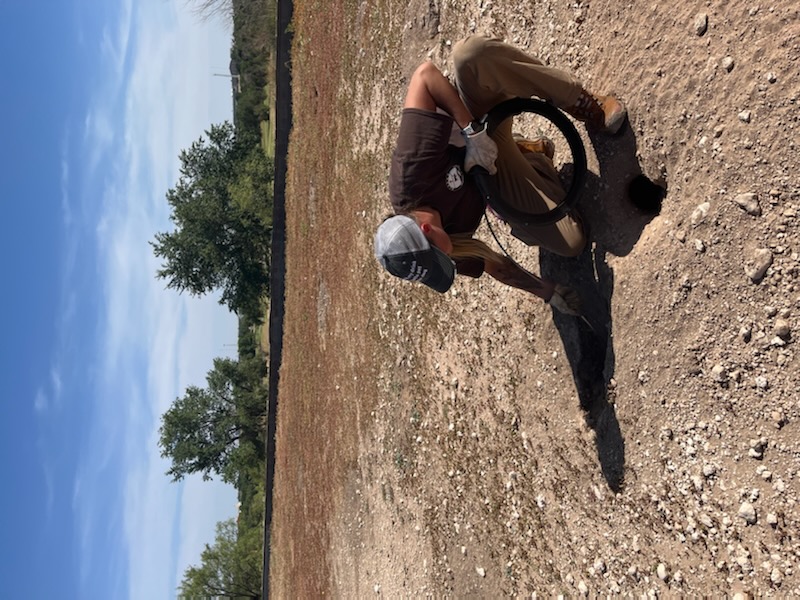Breadcrumb
UCM Instructor Has Novel Concept Research Published in Nature Communications
By Nicole Lyons, November 15, 2024
 Dawn Pauling, Ph.D., associate instructor of Biology at the University of Central
Missouri, conducts environmental
Dawn Pauling, Ph.D., associate instructor of Biology at the University of Central
Missouri, conducts environmental
research as part of her doctoral work with the University of Missouri. Pauling is swabbing
prairie dog burrows to collect
fleas during the field work portion of the project; the paper published in Nature
Communications is based on her lab work.
Cementing her place in scientific history, Nature Communications has published novel research from a University of Central Missouri (UCM) faculty member.
Dawn Pauling, Ph.D., associate instructor of Biology, and three colleagues from the
University of Missouri-Columbia authored “Transovarial transmission of Yersinia pestis in its flea vector Xenopsylla cheopis.”
Nature Communications is a subset of Nature, considered the world's leading peer-reviewed multidisciplinary scientific journal.
“I don't know how to compare it to anything else because it's such a unique thing,”
Pauling said of being published in Nature Communications. “But it is a big deal and
it's a pretty big accomplishment that I keep trying to tell myself is actually real.”
Scott Lankford, Ph.D., chair of the Department of Biological and Clinical Sciences,
said Pauling has had an incredible start to her career. Being published in the Nature
family of publications is typically a long-term achievement, and Pauling already has
her name in the journal as an associate instructor.
“Not only has she achieved all this work in that time period, she's also helped build
up the structure at UCM to make more of this work possible and taken the leadership
to make sure that's done right on our campus,” Lankford said. “The amount of background
and extra work that it takes to have a collaboration that spans two universities and
federal and state-level labs, it's been quite an achievement. We really couldn't be
more proud.”

As part of her doctoral work at MU, Pauling worked in a microbiology lab that focused on Yersinia pestis, “the causative agent of plague, which is classified as a prioritized re-emerging zoonotic disease transmitted by fleas.”
“We do a lot of things in the lab, which are very important and very informative,
but I always want to make sure that it can lead back to the natural setting,” Pauling
said. “Just looking into some of the literature, there were just a lot of knowledge
gaps as far as how we go from these cycles where we're not seeing a lot of mortality
to these epizootics where you see a lot of mortality and it's very quick. The mechanisms
that had been suggested didn't make sense for this rapid mortality to occur in such
high numbers.”
Pauling began investigating environmental factors and the localization of the pathogen
within the flea vector. She was trying to find what factors contributed to pathogen
persistence and increased transmission by the flea. She said that despite indications
from early studies that the bacteria does not leave the flea’s midgut, there were
too many questions. The MU research team eventually found the pathogen entered reproductive
tissue.
According to Pauling, the discovery was a novel concept in a scientific field that
has been around for more than 100 years.
“It was terrifying at first because you're going to make this statement, which is
something the whole field has said doesn't happen,” Pauling added.
Beyond the excitement about being published in a prestigious scientific journal, the
impact of the research could be long-lasting. The information opens up a new path
for understanding decades-long knowledge gaps regarding how the pathogen persists.
Yersinia pestis is the causative agent of plague, which most people associate with
the bubonic plague and black death, pandemics that happened centuries ago. However,
Pauling explained that it is still persistent and has been in the United States since
1901.
“We don't see a lot of it (in the U.S.), but in other countries, we see a lot of deaths
associated with it,” Pauling continued. “Trying to figure out how it's there, why
it's there and why it's persisting will hopefully lead to new avenues to be able to
try to remove it from the environment and find ways to reduce overall exposure for
people.”
Pauling earned her doctorate last year, and the team is moving forward with additional
projects related to the Yersinia pestis research. While it may have felt terrifying
at first, Pauling said that her decision to ask new questions about something that
was seemingly answered has opened up many different kinds of novel pathways.
“I think it's really cool that even now, you can show that it's OK to ask the questions
that go outside the box, even though the field has already set that box,” Pauling
said. “It's OK to do that because it can lead to really cool things like this.”
For more information about the Department of Biological and Clinical Sciences, visit
ucmo.edu/biology.








